Support strong Canadian climate journalism for 2025
The amount of wood in Canada’s forests has declined relentlessly for decades.
According to a new survey by Natural Resources Canada, our forests have lost a total of four billion cubic metres of wood volume since 1990. That translates into the loss of hundreds of millions mature trees. The missing wood is enough to stack more than a billion cords of firewood — or to build around four homes for each Canadian.
Where's the wood going? Logging has been hauling it out faster than Canada's forests — weakened by decades of industrial forestry and rising climate impacts — can regrow. That imbalance is pouring billions of tonnes of CO2 onto our metastasizing climate crisis. It’s a rising climate threat that our government greenlights by keeping it off our nation’s official climate books.
Four billion cubic metres lost
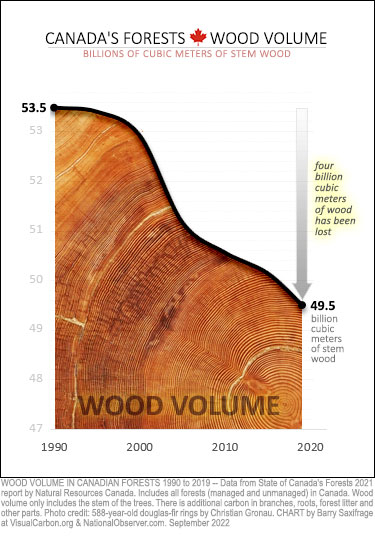
My first chart shows the results of this new survey of wood volume, published in this year’s State of Canada’s Forests report.
Back in 1990, our nation’s forests contained 53.5 billion cubic metres of wood. Today, they are down to 49.5 billion cubic metres.
As the chart’s plunging line illustrates, the decline has continued relentlessly downward for 30 years. It’s a consistent long-term trend.
Natural Resources Canada says this new survey is its most accurate so far. Using significantly improved data collection, forest models and satellite imagery it has been able to paint a sharper picture.
And it is an increasingly dystopian portrait. Using these more-accurate methods, the amount of wood volume estimated to have been lost since 1990 jumped by a billion cubic metres compared to the old method.
A rising climate threat
This long-term decline in Canadian wood volume is adding huge amounts of CO2 to the atmosphere. All those billions of cubic metres of lost wood were chockfull of carbon. And that carbon has been turning into CO2 as that wood burns and rots.
The primary use of harvested wood in Canada is to burn it for energy. Second is making paper and other short-lived products. These are burned or rot within a few years of harvest. Only a small amount goes into long-lived products like houses and furniture.
If our forests were, instead, growing back as fast as they were losing wood, then new growth would be pulling CO2 out of the air as fast as the dead wood emitted it. That’s the theory behind labelling some harvested wood as “carbon-neutral.”
But that’s clearly not what has been happening in Canada. In Canada, our forests aren’t replacing wood as fast as they are losing it. And that rising imbalance is creating a rising climate threat.
How big of a climate threat are we talking about?
Unfortunately, Natural Resources Canada doesn’t discuss the climate implications in any detail in its report. So, to try to provide climate-concerned Canadians with some sense of the scale of the problem, I’ve done my best to estimate the resulting emissions.
Around five billion tonnes of CO2
To understand the scale of the climate threat posed by all that missing wood, we need to know how much carbon it held. By digging deeper into the new survey’s data tables, I discovered that Canada’s forests contain, on average, one-third of a tonne of carbon for every cubic metre of tree volume.
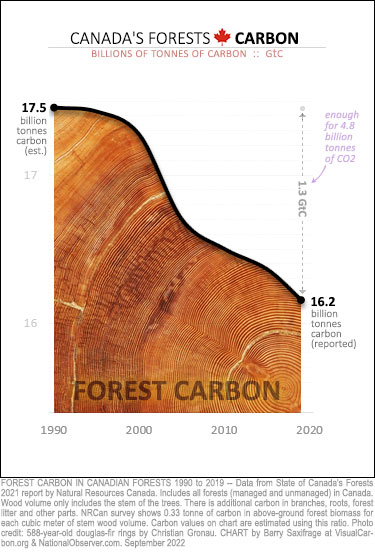
I applied this national average to all the wood volume numbers. My second chart shows the result in billions of tonnes of carbon.
Losing those four billion cubic metres of wood volume translates into losing an estimated 1.3 billion tonnes of stored carbon.
And that much carbon will produce nearly five billion tonnes of CO2 when it all burns or rots. That works out to an annual average of 165 million tonnes of CO2 (MtCO2) per year since 1990.
(Note: When a carbon molecule turns into CO2, the weight increases nearly four times because of the added oxygens. See the endnotes for details on this and many of the other forest carbon stats used in this article.)
How many Canadian fossil-fuel-burning cars will we need to take off the road to offset this 165 MtCO2 each year? All of them. Plus, all our heavy-duty freight trucks and every other form of fossil-fuelled road transport. Oh, and we’ll also need every Canadian home to stop burning natural gas.
It’s an enormous amount of CO2 pouring into the atmosphere. Unchecked, it threatens to wipe out decades of climate efforts Canadians make in other sectors.
Much of the potential CO2 from all that missing wood has already been emitted. That’s added billions of tonnes to our atmosphere, intensifying climate damages. The rest is “zombie CO2” — dead carbon waiting to arise as CO2 when it eventually rots or burns.
The role of logging
One of the primary ways our forests have lost wood volume is on the backs of logging trucks.
Canada tracks the amount of carbon logged out of our forests and what happens to it. This gets reported each year in Canada’s National Greenhouse Gas Inventory Report (NIR).
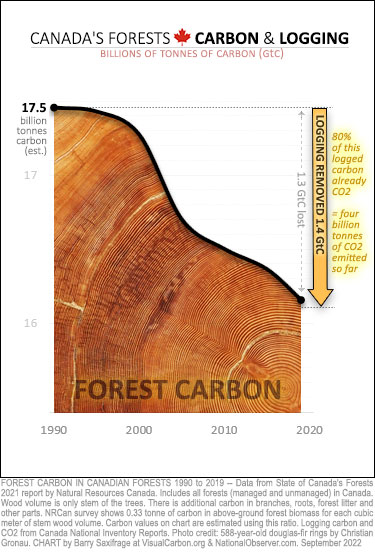
Those numbers show that since 1990, logging removed a total of 1.4 billion tonnes of carbon from our forests. That’s indicated by the big orange arrow on this chart.
The NIR also shows that around 80 per cent of this logged carbon has already emitted four billion tonnes of CO2.
The remaining 20 per cent is zombie CO2 — waiting in wood harvested since 1990 that is still in use. That’s another one billion tonnes of CO2 in the pipeline.
As you can see on the chart, Canada's forests haven't been able to grow back what has been logged out of them.
Does that look “carbon-neutral” to you? It sure doesn’t to me … or to the atmosphere.
Carbon-neutral … on paper
Our Canadian government, however, still officially claims that logged wood is carbon-neutral.
Maintaining that status hasn’t been easy. To produce a thriving forest on paper, the government has been forced to make multiple changes to its forest carbon accounting rules. The most consequential change has been to push off the books large parts of Canada’s forests that are emitting the most CO2. Once these forest areas recover and are pulling in CO2 again, they get put back on the books. This has allowed the government to create a paper forest that is in CO2 balance. (For details on these accounting changes, see As Canada's forests become carbon bombs, Ottawa pushes the crisis off the books.)
But it isn’t keeping the hidden CO2 out of the atmosphere. And it isn’t getting us to climate safety.
Instead, Canada exempts the billions of tonnes of CO2 arising from harvested wood from carbon pricing and from its emissions-reduction targets. This serves to encourage yet more logging and Canada’s forests can't keep up.
Some people still claim it will all work out fine because Canada’s forests will eventually regrow all that missing wood. But after three decades of continuing forest losses — and with climate impacts rapidly intensifying in our forests — these assurances of massive sustained forest growth just around the corner look more and more like a mix of climate denial and predatory delay.
If we want any chance of avoiding a dystopian climate future for Canadians and our forests, we must stop all sources of climate pollution. That includes the billions of tonnes of CO2 we’re contributing by harvesting wood faster than Canada’s forests are growing it back.
Our northern 'unmanaged' forests aren’t saving us
One last insight in these numbers concerns the carbon health of our more northern “unmanaged” forest. The Canadian government categorizes our forests into two parts: “managed” and “unmanaged.” These are shown on the map below.
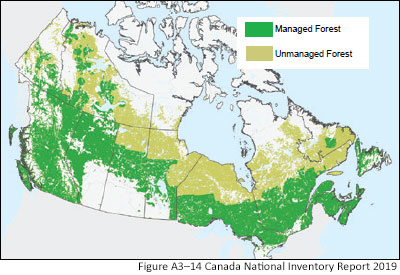
The official forest carbon data — published each year in the NIR — only covers the managed forest.
That data shows that our managed forest is in big trouble. Weakened by decades of poor land use decisions and rising climate impacts, net forest growth has steadily collapsed to the point where the managed forest area has flipped from absorbing CO2 to emitting it. Despite this collapse, logging continues to harvest wood at business-as-usual high levels.
Here are some numbers to illustrate. Over the last decade, Canada's managed forest emitted 200 MtCO2, while the wood harvested from it emitted another 1,400 MtCO2. Combined, they added 1,600 MtCO2 to the atmosphere. That’s an average of 160 MtCO2 emitted each year.
Many of us watching this rising flood of climate pollution have been holding out hope that somehow our more northern “unmanaged” forests were thriving enough to offset this CO2.
So, I was excited to learn that these new wood volume estimates from Natural Resources Canada cover all Canadian forests — both managed and unmanaged. That means our government has the data for the missing part of the forest carbon puzzle — what’s been happening in our northern unmanaged forests.
Unfortunately, when I asked Natural Resources Canada for a breakdown of its wood volume estimates into managed and unmanaged forests, it said it couldn’t give them to me because … they don’t use those forest categories.
Honestly, I don’t even know what to say about that.
So, the best insight I can offer with the data made available is that even when the unmanaged forest is included in the mix, Canadian forest carbon losses have plunged relentlessly downward. Our unmanaged forest hasn’t been able to turn the tide as many of us had hoped.
Worse, there are signs our unmanaged forest might be adding to the climate threat.
Foreboding …
Adding urgency to the need to understand what’s going on in our more northern unmanaged forest are recent reports that many of the world’s most northern forests appear to be tipping into CO2 emitters.
Human-caused climate warming — which is overwhelmingly caused by burning fossil coal, oil and methane gas — is happening two to three times faster in boreal and sub-arctic forests than the global average. This more rapid northern heating is causing rapid changes in wildfires, lightning, drought, snow cover, surface albedo, insects, disease, melting permafrost, and a host of other environmental shifts. Such dramatic changes threaten to damage these forests, increase emissions, and turbocharge global heating even faster.
As Natural Resources Canada warned in last year’s State of Canada's Forests 2020 report: "Scientists predict that increasing temperatures and changes in weather patterns associated with climate change will drastically affect Canada’s forests in the near future. With the rate of projected climate change expected to be 10 to 100 times faster than the ability of forests to adapt naturally."
We are running out of time to save our forests — and ourselves.
***
Endnotes
Here’s more of the geeky details for those who want to dig a bit deeper.
WOOD VOLUME NOTES
- National Resource Canada published a time series for forest wood volume from 1990 to 2019 in its State of Canada’s Forests 2021 report here.
- Its forest wood volume numbers only include the stem of trees. There is additional woody biomass (and carbon) in branches, foliage, bark, roots, etc.
- Natural Resources Canada also publishes more detailed data tables from the survey online here. But these only cover the current situation. They don’t provide a time series showing changes since 1990.
- The survey includes all forests in Canada — both managed and unmanaged.
- As an example of a mature tree, a Douglas fir that is 100 feet tall and two feet across at “breast height” contains four cubic metres of stem volume (link). The four billion cubic metres of lost stem volume equals a billion trees this size.
- A “cord” of firewood is 3.6 cubic metres in volume. That includes the air between the pieces of wood. Using an estimate of one-third being air yields ~2.4 cubic metres of wood per cord. Four billion cubic metres of wood equals roughly 1.6 billion cords.
- One estimate I found (link) says that it takes around 12,600 board feet to build a typical 2,000-square-foot home. That’s ~30 cubic metres of wood. Four billion cubic metres of wood is enough to build around 135 million such homes — nearly four per Canadian. Currently, there are 15 million households in Canada (link).
FOREST CARBON NOTES
- The only forest carbon statistic I could find in the survey data was a single value listing “total above-ground carbon in Canada” forests at 16.3 billion tonnes of carbon (table 19).
- When divided by the 49.5 billion cubic metres of stem wood listed for the forests, it yields a national average of 0.33 tonnes of above-ground forest carbon per cubic metre of stem wood.
- I used this ratio to convert all stem wood volume numbers since 1990 into carbon estimates. This is a rough approximation, in part because there is additional carbon in roots and soil that isn’t included but can be lost when trees are logged, burned or die in other ways. Also, because the government hasn't published carbon values for other years, I’ve used the current ratio of forest carbon to stem wood for all years. If that ratio changed significantly since 1990, then this would not be reflected in my estimates.
FOREST CARBON INTO CO2
- Forest carbon is usually measured in tonnes of pure carbon.
- When carbon turns into CO2 — like when it burns or rots — two heavier oxygen molecules from the air are added on. The weight of the CO2 molecule is 3.67x the weight of the carbon molecule alone. In atomic units, the ratio is 44/12. That increased weight of CO2 is why 1.3 billion tonnes of wood carbon can turn into 4.8 billion tonnes of CO2.

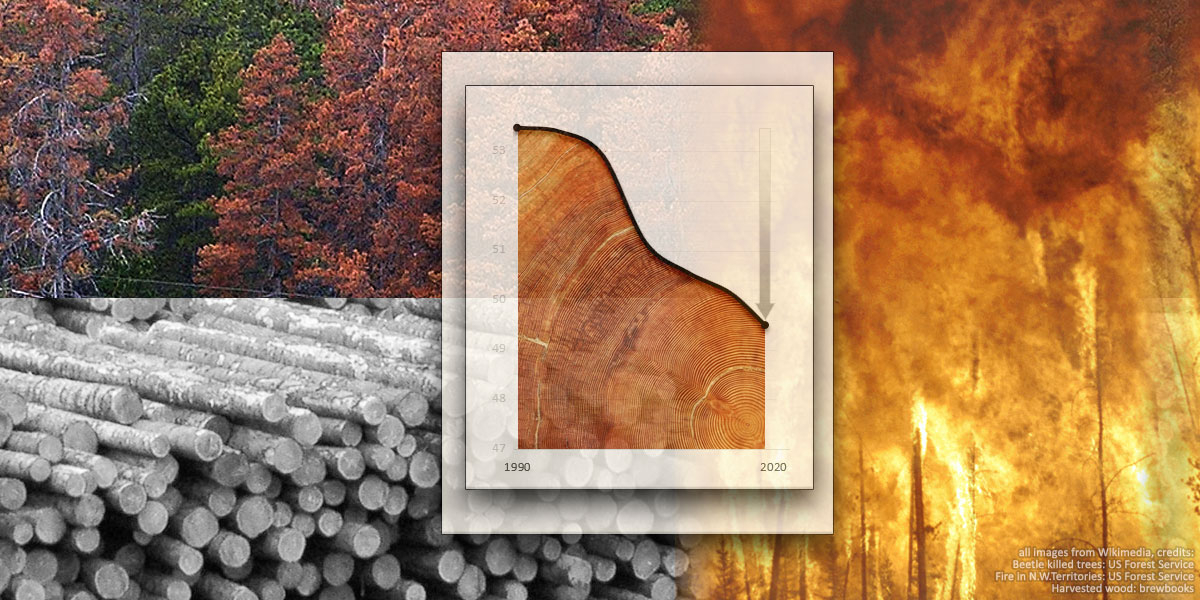


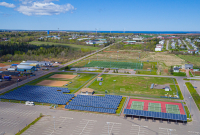

Comments
This article is a good example of statistical abuse in the service of alarmism.
But at least there seems to have been some retreat from the notion that old-growth absorbs carbon forever and so logging any of it means we’re doomed, and of the notion that regrowing forests are somehow net emitters of CO2.
So there’s that…
Now, what about the shell and pea inventory?
Whereas our government has been indulging in statistical abuse in the service of complacency.
Ironically, even with the notes and geeky details (for which millions and millions of thanks, Barry), this *still* undershoots the total impact, all tolled. Because in addition to the roots and such underground, there is also a huge "community" of symbiotic "little creatures" that live in the soil. Once the species upon which a given underground symbiote cannot survive overheating of the soil, or loss of its symbiant partner. Some of them only travel a few feet in several decades. So one tree with an intact underground population, somewhere "over there" can't repopulate the area. Neither can such a population traverse the logging roads.
Plantation-grown replacements for intact forest also have wood that is less dense, and considerably weaker than that from "intact" forests, in addition to supporting less non-plant biodiversity.
When our forests are in such bad shape, and our air is in such bad shape, it's beyond folly, it's predatory stupidity, to be cutting for export.
(I've developed a sneaking suspicion that Mr. Saxifrage reads comments that people leave. Otherwise, I'm flattered beyond measure that the questions I have to some extent mirror those he considers worthwhile to answer.)
Now ... where does one go to nominate him as a national hero!
PS: Old growth forests' "environmental work" extends far beyond the measure of board feet. Quite aside from the fact that they do, in fact, sequester more carbon per year than replanted patches.
PPS: Had enough trees been left standing in the first place, there wouldn't be the rapid runoff flooding that's now a matter of course in BC. Ditto if meandering rivers and streams had been left as is, instead of being bulldozed into canals with dyked sides.
PPPS: People who "aren't old enough" and who haven't been actually watching a given area over time, have no idea what's actually been lost. I had a really good cry, visiting my hometown, with all the hillsides denuded in the course of resource extraction, one way or another.
Another terrifying and brilliant Saxifrage piece.